
‘Only two German actresses have captured the sustained imagination and enthusiasm of the American filmgoing audience: Marlene Dietrich, who appeared only once in a German film before developing her career in America, and Hanna Schygulla, who chose to stay in Europe, where her career has flourished for more than three decades. Nurtured by the writer-director Rainer Werner Fassbinder—she appears in 18 of his films—Schygulla continued, after Fassbinder’s death, to work with such major filmmakers as Marco Ferreri, Jean-Luc Godard, Margarethe von Trotta, and Andrzej Wajda. Schygulla’s performances are so unmannered that she elevates the films in which she stars, no matter how artificial, to the level of truth.’ — MoMA
‘Their names are closely entwined: Hanna Schygulla and Rainer Werner Fassbinder. The actress became the female anti-star of Germany’s most successful filmmaker in the 1970s and early 1980s and thus the face of New German Film. Schygulla’s unique presence in the role of Maria Braun made her world famous. And she likewise played Effi Briest and Lili Marleen. Writer Georg Stefan Troller once described Hanna Schygulla as “on the one hand overwhelmingly feminine, soft and on the other, standing aloof above thing. She is a narcissus bereft of vanity.”
‘After Fassbinder’s untimely death in 1982, her long-standing collaboration with directors the likes of Jean-Luc Godard, Marco Ferreri, Ettore Scola, Andrzej Wajda, Alexander Sokurov and Fatih Akin made her one of the very special actresses in European cinema. As early as 1983, Hanna Schygulla won the award for best actress in Cannes – for her role in Marco Ferreri’s film “Storia di Piera”.
‘In her autobiography, entitled “Wach auf und trauma”, which she published at the end of 2013 to mark her 70th birthday, now firmly a Parisian she tells of her time with Fassbinder and her life in three home countries, namely Poland, Germany and France. Born in Kattowitz in Silesia, she fled with her mother to Munich and grew up during the years of the German economic miracle. Aged only 20 she met Fassbinder: “He was to become the most important person in my path as an actress.” However, after almost 20 years this meeting of creative minds ended in anger. After falling out with Fassbinder Hanna Schygulla moved to Paris, where as a young woman she had already learned the language. There, she continued to work in the movies, but chose to put her career “on hold” for a few years when her elderly parents suddenly needed caring for. Indeed, Hanna Schygulla’s autobiography also tells the tale of the person behind the actress.’ — deutschland.de
___
Stills


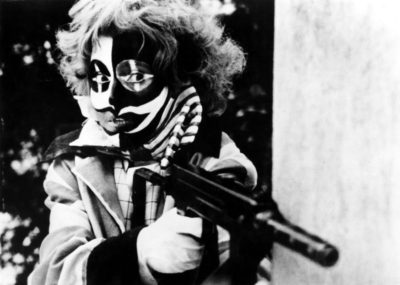
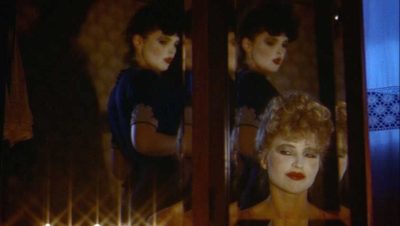
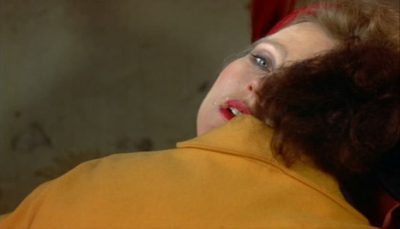
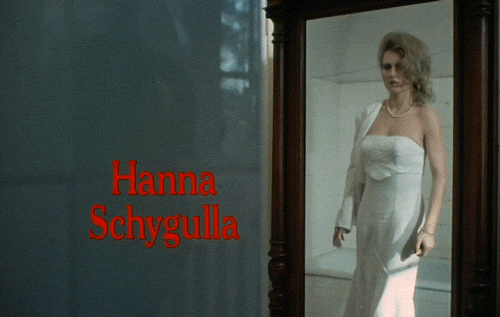
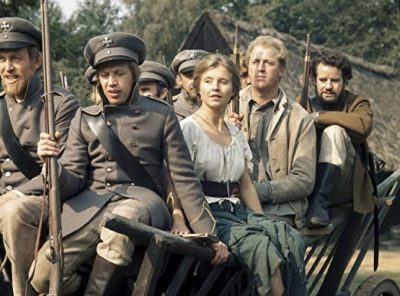
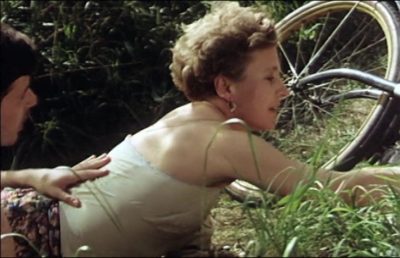
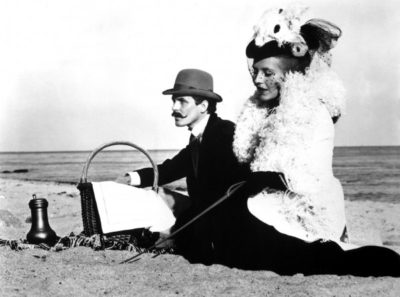


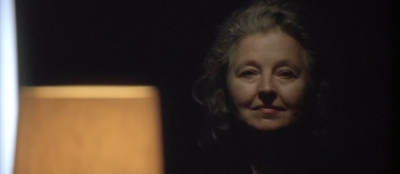
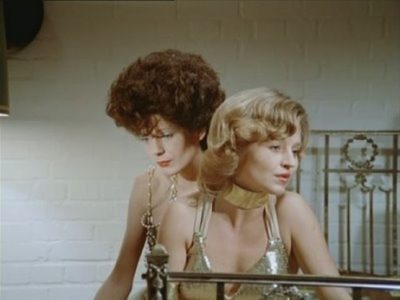
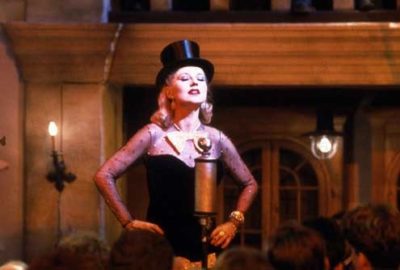
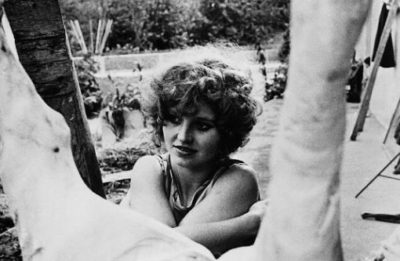

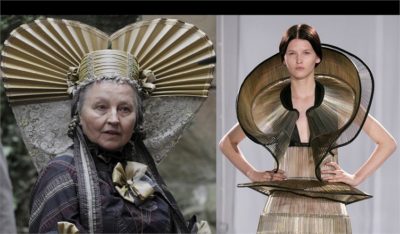
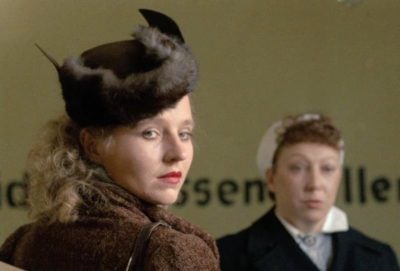
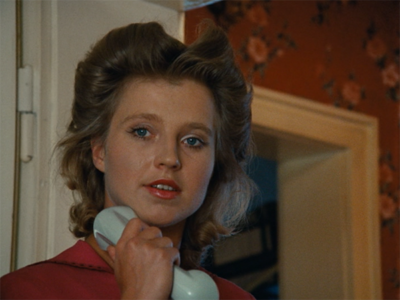

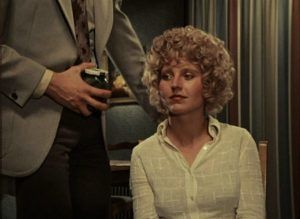
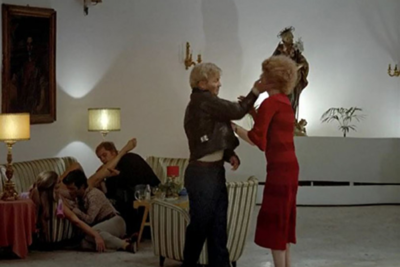
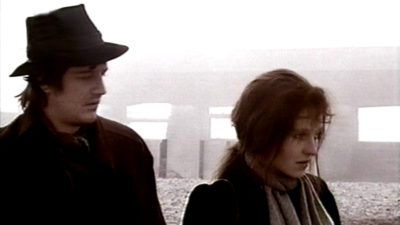

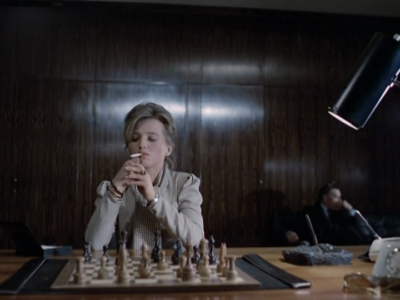
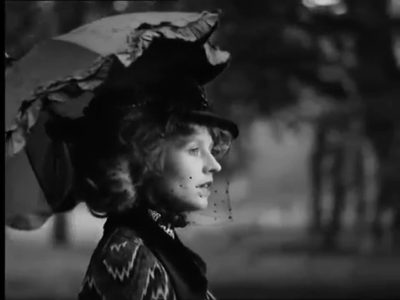
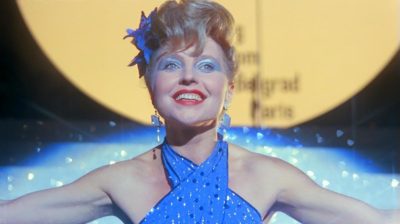



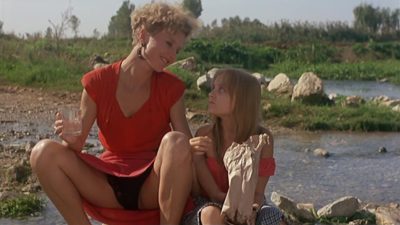
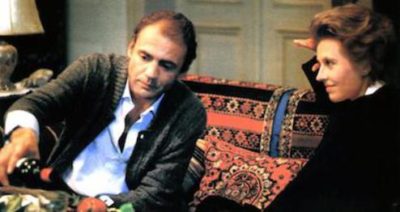
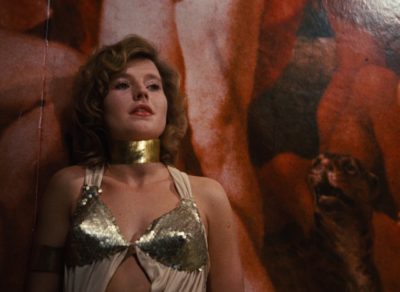
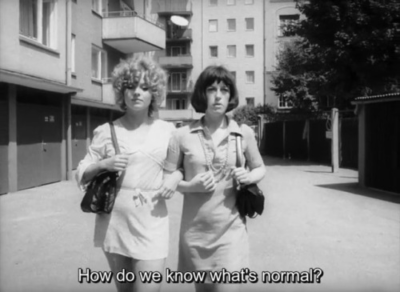
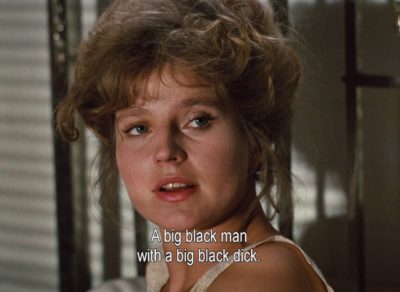
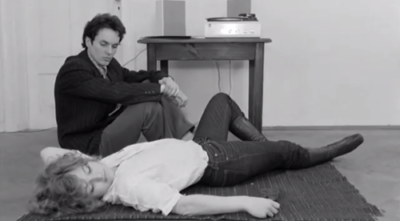

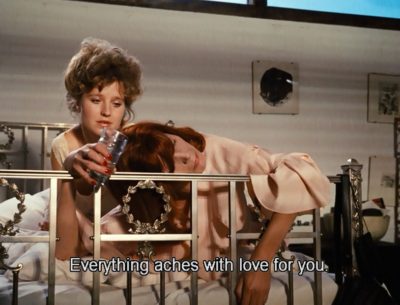
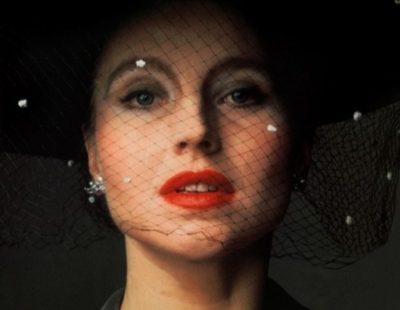
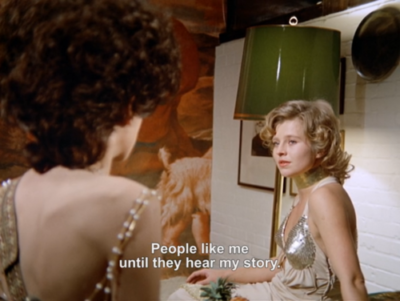
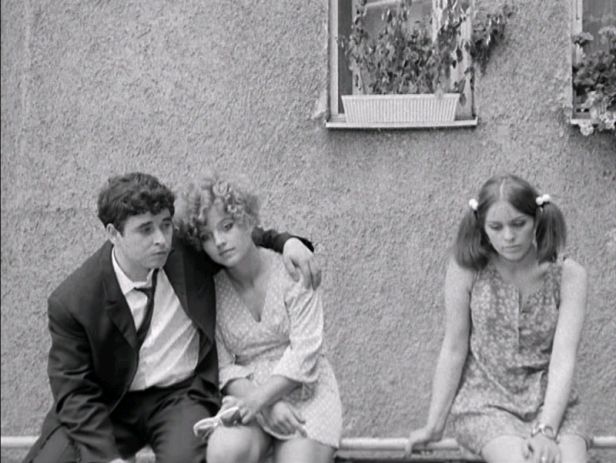

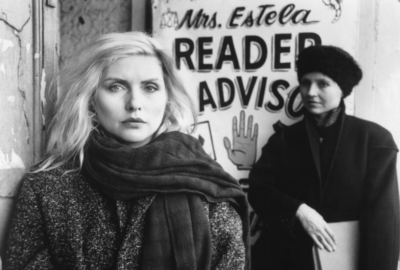
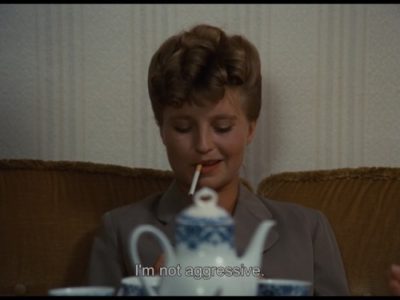
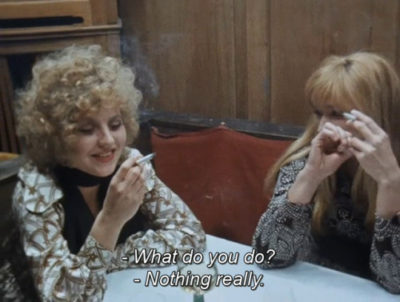
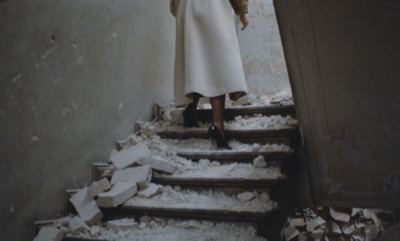
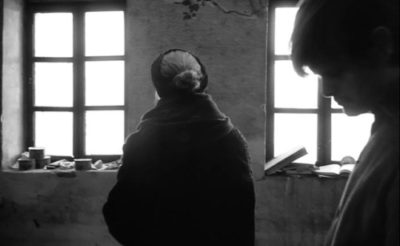




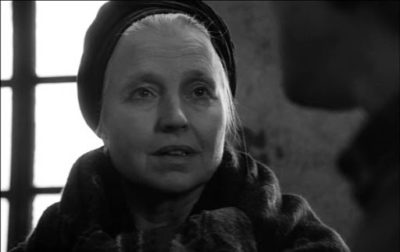
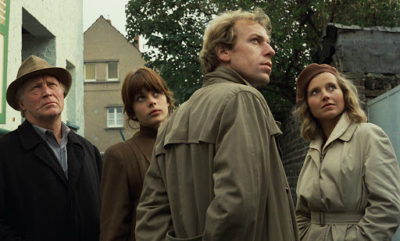

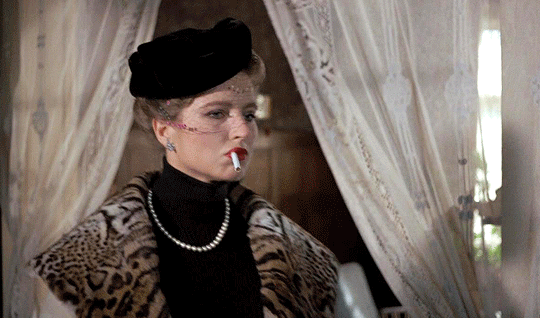
____
Further
Hanna Schygulla @ IMDb
The muse and the monster: Fassbinder’s favourite star on surviving his abuse
Les musiques d’Hanna Schygulla
Hanna Schygulla Remembers Rainer Werner Fassbinder: ‘I’m One of the Survivors’
Actress Hanna Schygulla looks back
Hanna Schygulla, 56 ans, égérie de Fassbinder, revient au théâtre de la Villette, auteur, actrice, chanteuse.
15.6. Morning Discussion with Hanna Schygulla
Hanna Schygulla: «Je veux des films qui me donnent des ailes»
Veteran German Actress Hanna Schygulla Criticizes #MeToo
Hanna Schygulla: la musa de Fassbinder cumple 75 años
HANNA SCHYGULLA @ MUBI
Hanna Schygulla veut encore rêver
Who was Hanna Schygulla: from au-pair to cinema legend
Hanna Schygulla: ‘Fassbinder had very concrete ideas about the choreography of bodies’
Video: Hanna Schygulla on THE MARRIAGE OF MARIA BRAUN
Book: Hanna Schygulla, by Ulrike Sieglohr
Hanna et ses films
Hanna Schygulla : Un amour impossible en Allemagne
Europe’s Incandescent Hanna Schygulla Blazes
_____
Extras
Hanna Schygulla interview, 1982
Hanna Schygulla, Actress and Chanteuse
Fresque biographique de Hanna Schygulla
Hanna Schygulla on Rainer Werner Fassbinder
____
Interview
from Little White Lies
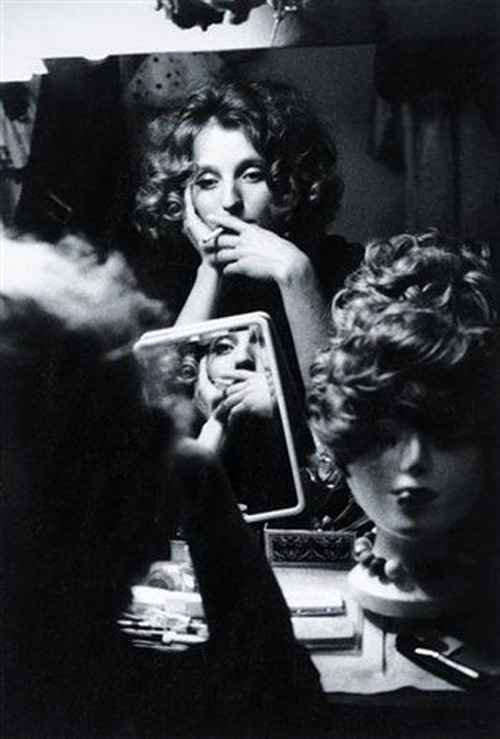
LWLies: The 1968 short film, The Bridegroom, the Comedian and the Pimp, was your first time in front of a camera. How did that feel?
Schygulla: The director was Jean-Marie Straub, who is quite a phenomenal artist though he’s not very known. He was shooting the moments of a play when the actors entered or left the stage. That idea was unusual, and for us it felt not that different to what we had been doing stuff like that on stage. Fassbinder was into what he liked to call “anti-theatre”, meaning that because he didn’t have the money to do films, which is what he always wanted to do, he did theatre a little like film. So he would change and alter the angle of looking at how a story is told. He always liked to turn things around.
Is there a difference in playing for a camera than working in theatre?
In the first movies, no. Because the camera was not very close to us. It was a way to get into it which was not particularly cinematic. But as Fassbinder’s career went on, his camera got closer to us.
Did you have time to reflect on the performances, or was it a case of just moving on to the next film?
He wanted everyone to look at the rushes. At the time, you couldn’t just have a video and play it back instantly. The film was developed and then we’d all sit down and look at what had been shot. It was like a ritual. He’d talk about what could be done better or differently.
Did he ask for your feedback?
No.
So why did he want you to see the rushes?
He was a man who embodied opposing forces. On one hand, he was the total filmmaker. He knew exactly what he wanted. On the other, he gave quite a bit of responsibility to everyone taking part in the film. People liked working with him because he only interfered when he had a clear way he wanted to go and it was that way and no other. If not, he liked that people had their own creativity.
You starred in the TV series Eight Hours Don’t Make a Day, where you wear a giant perm wig throughout. Is that something Fassbinder asked you to wear or did you choose it yourself?
No, no. We stuck closely to an image we had found. Before, my hair was my hair. But then I thought, ‘Oh my goodness, if I do six chapters, I’ll always have to mess up my hair, so why not just use a wig?’ When I saw it I realised that a wig never actually moves like your own hair. He didn’t say he wanted me to look like that. He’d only tell you when he didn’t like something. Actually he didn’t tell you, he just pulled a face. So then you’d try to offer something else.
Was this the same on takes? Did you get the face?
He wanted to get a certain choreography, meaning the interplay of bodies in the frame.
Would he physically move your body?
Yes, this absolutely was his way to direct. He never gave psychological explanations. He didn’t talk about roles or characters. He had very concrete ideas about the choreography of bodies and certain gestures that had to be accomplished. He would occasionally leave it to us to invent something. But most of the time he would arrive on set with these little drawings. They were very schematic. That was his homework. That was why he could work so quickly. He knew. He learned filmmaking by film watching.
Did he ever get yourself or the group to watch the films he liked?
Not systematically. But we watched Antonio das Mortes by Glauba Rocha. We watched The Damned by Visconti. He wanted us to see Vivre sa Vie by Jean-Luc Godard, which he saw more than 20 times. He would do by watching. And this is why he had those images that he wanted to quote. He watched whatever was on. He watched movies just keep himself out the house. In his early life, he didn’t get along with his step father, so he would go and watch movies all day.
Do you remember the first time you and Rainer met?
Yes, I do. I was in university and I getting kind of tired of it. The process of becoming an intellectual was frustrating for me. I was making some extra money at the time working as a waitress. One of the other girls at the restaurant told me about drama school, and she invited me along. I said why not. The coincidence was that he was in the same class.
Did he approach you?
It was a private school. We only met once a week. Everyone would improvise on a theme, and then afterwards we’d all go and drink beer. We did not talk much. He was extremely shy, especially with me. Once he saw a scene that I had been improvising, and he made his boyfriend come up to me and tell me that he liked it very much.
Did you then approach him?
No. I just found that very strange. He was clearly the rebellious type, so I couldn’t quite understand what he liked about this scene. It was Goethe, and a love scene between two people who were supposed to be brother and sister. It wasn’t really a love scene, in the sense of any sexual intercourse, but it was all based on not showing feelings. Later I understood why he liked it, because that was the kind of relationship that we had.
Did he ever tell you why he kept casting you in his films?
No. He would make remarks to the others, tell them that ‘she’s a star’ or whatever. But to me, no, never. When I said I need a break and I want to get some distance, he was so hurt. I took four years before he got over that. He contacted me to be in The Marriage of Maria Braun.
Is there a Fassbinder film that you wanted to be in but you weren’t cast?
Yes. That was Lola. He said that the next film we’d do is Lola. Then, while we were filming Berlin Alexanderplatz, we were crossing in a doorway. And in this very casual way, he told me that he’d cast Barbara Sukowa in Lola. I said, ‘Okay, why?’ and he said that I’d been talking too much about it. And I said that I was doing promotion for Maria Braun and everyone would ask what the next film would be. For some reason, that annoyed him. Or maybe he got fed up with me?
How often were you in contact with Hollywood?
Not much. I had been there once for sure, but I can’t remember which studio I went to. I did Dead Again with Kenneth Branagh which was shot in Los Angeles. David Lynch did get in touch with me once. He sent me the script for a film called Blue Velvet. I found it horrifying. It was for the part of Dorothy Vallens [played by Isabella Rossellini]. The script didn’t feel at all like the finished movie. It was about a man who violates a woman, he keeps her in captivity and badly mistreats her. He even has his hand on her child. Then she almost starts liking it. When I read it I thought it was really sick stuff. That doesn’t mean that I wasn’t aware that he was a good filmmaker. At the same time I was dealing with the fact that my mother was becoming old and I was living a very different life. The emotions I was experiencing at that time just made me think that I couldn’t do it. It seemed to me… kinky.
Did you see the film in the end?
Yes, I saw it and thought it was quite a good film. Especially the beginning and the end. I wrote David a letter telling him that I never would have guessed that that film would have come from the script he sent me. I’m not used to regretting decisions I make, as regret is a feeling that doesn’t create anything. But I said that if he asked me another time, I would say yes. But he never asked.
______________
23 of Hanna Schygulla’s 103 roles
______________
Peter Fleischmann Hunting Scenes from Bavaria (1969)
‘A young farm mechanic Abram returns home to a remote village in Low Bavaria, after a short stay in the city. Soon, rumours spread that Abram was in prison because of his homosexuality and he is accused of raping the village idiot. Abram escapes to the forest and a man hunt begins. In an excruciatingly precise manner, the film exposes the murderous process of exclusion in a community where ferocious behaviours hide behind righteous attitudes, forty years before Michael Haneke’s The White Ribbon. Hunting Scenes from Bavaria is the first critical Heimat film of “New German Cinema”.’ — le pacte
Trailer
_____________
Rainer Werner Fassbinder Love Is Colder Than Death (1969)
‘For his feature debut, Rainer Werner Fassbinder fashioned an acerbic, unorthodox crime drama about a love triangle involving the small-time pimp Franz (Fassbinder), his prostitute girlfriend, Joanna (future Fassbinder mainstay Hanna Schygulla), and his gangster friend Bruno (Ulli Lommel). With its minimalist tableaux and catalog of New Wave and Hollywood references, this is a stylishly nihilistic cinematic statement of intent.’ — The Criterion Collection
Excerpt
____________
Volker Schlöndorff Baal (1970)
‘Schlondorff presents his adaptation of a Brecht play as 24 numbered (and distinctly separate) scenes, and uses several other distancing techniques in the Brechtian mode. Real exteriors and interiors are used instead of studio sets, but the theatricality is retained in the physical stagings and (sometimes deadpan) line readings. Hand-held camera-work is frequently (but randomly) distorted by application of Vaseline-smeared lens to create a diffused, haloed image, a technique popularized at the time by the son/father filmmaking team of Jean- Gabriel & Quinto Albicocco in the classic adaptation of LE GRAND MEAULNES.’ — lor_
Excerpt
_______________
Rainer Werner Fassbinder Why Does Herr R. Run Amok? (1970)
‘Herr R. (Kurt Raab) has a wife and a child, a medium-size rental apartment with a garden, he owns a TV set, and comfortable furniture complete his middle class existence. His work at home and in the office fulfills him, hobbies offer him a change; and then Herr R. loves peace and quiet. The machinery of everyday routine functions. At work – Herr R. is an engineering draftsman – the colleagues are nice, his boss (Franz Maron) is content, his wife (Lilith Ungerer) picks him up every day after work in their car. He corrects his son’s homework, invites the in-laws and an old school friend on Sunday afternoons, a promotion is in sight. Everyone is happy. It appears that without too much mental or physical complaint, Herr R.’s self-realization will be possible. Then one evening – a neighbor (Irm Hermann) has just stopped by – Herr R., like a machine, attacks his wife, child, and neighbor.’ — TFF
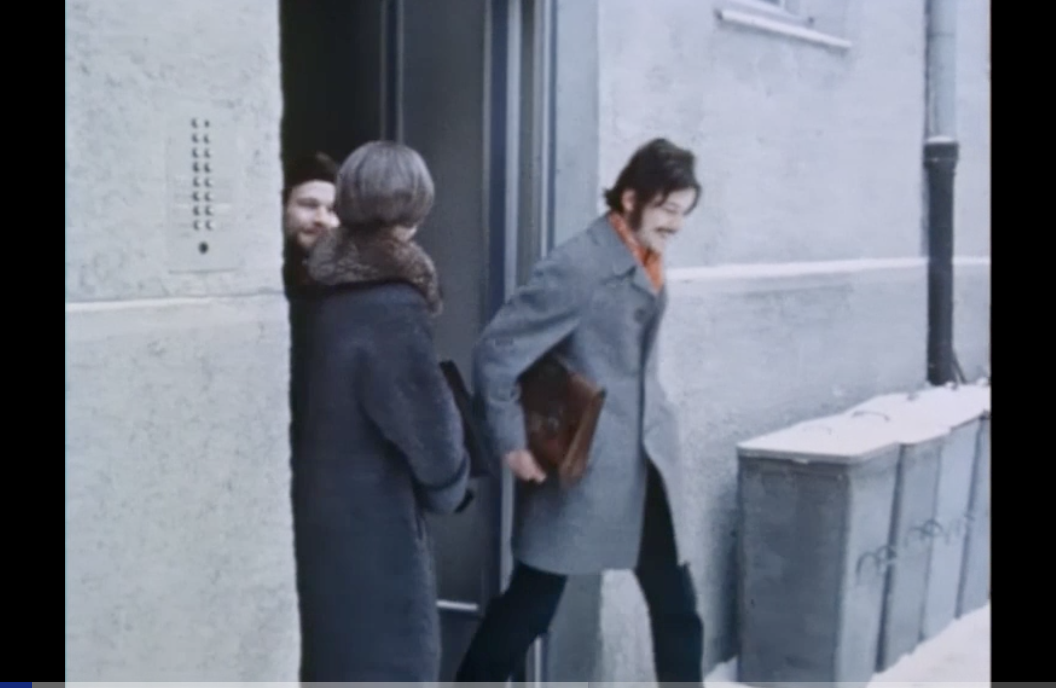
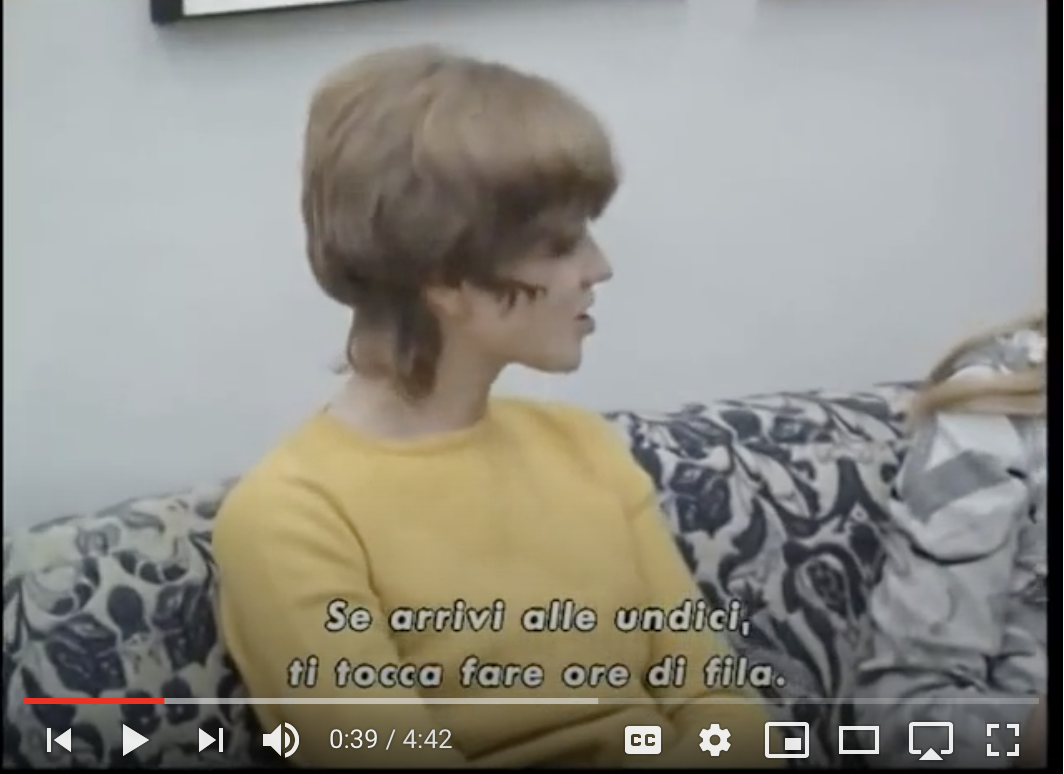
Watch the entirety in German (with Italian subtitles) here
______________
Rainer Werner Fassbinder Whity (1971)
‘Whity is the mulatto butler of the dysfunctional Nicholson family in the south-west U.S. in 1878. The father, Ben Nicholson, has an attractive young wife, Katherine, and two sons by a previous marriage; the homosexual Frank and the disabled Davy. Whity tries to carry out all their orders, however demeaning, until various of the family members ask him to kill some of the others.’ — Will Gilbert
Excerpt
______________
Rainer Werner Fassbinder Beware of a Holy Whore (1970)
‘If Love Is Colder Than Death is Fassbinder’s most underrated film—at once too gnomic and too precociously ruthless—then Beware of a Holy Whore is where Fassbinder incontrovertibly graduates from being a dazzling student of filmmaking to working on a level commensurate with the high masters. Shot for shot, scene for magnificently mortifying scene, this goes proudly toe-to-toe with the insider-straits of Wilder, Minnelli, and Godard; it also makes Johnny-come-latelys like Day for Night, Nashville, or Boogie Nights look like postcards from the edgeless. Could anyone ever order a “cuba libre” again after seeing this? A sardonic monster movie—well, a primer on how filmmaking can serve as permission slip for otherwise semi-decent, halfway sane people to behave as monsters, tyrants, frauds, cheaters, and infantile aggressors/victims—Beware packs a layered wallop of scorn, moral squalor, delicious absurdity, and flickering humanity. Playing the Fassbinder-ish director, Lou Castel’s Jeff is a wonderfully appalling self-projection, both as wish-fulfillment (a blond Adonis, he looks like he should be starring opposite Sandra Dee in a 1950s romance) and worst-nightmare-scenario (he acts like a bitter Caligula who fears he’s about to lose his throne and be forced to turn tricks on the street). It is a grand, sweeping indictment of the pettiness and rancor that can fester inside “art,” and yet it has one of the most perversely transcendental moments the movies have ever supplied. Schygulla dances slowly, this time à la Marilyn Monroe, to Ray Charles’s “Let’s Go Get Stoned,” while chaos reigns around her. Fassbinder wrapped up his first creative period with a suitable bang. This was no end-of-cinema lamentation, but a beguiling epitaph scrawled in ruby red lipstick on the medium’s grave: You ain’t seen nothin’ yet.’ — Howard Hampton
Excerpt
______________
Rainer Werner Fassbinder The Merchant of Four Seasons (1972)
‘Formally stiff and technically wobbly, The Merchant Of Four Seasons marked Fassbinder’s emergence as a punk classicist and a director of blunt gestures. He was all of 26 when he made it, with almost a dozen features and TV movies to his name. The year before, he had discovered the films of Douglas Sirk, the German-born master of Hollywood melodrama, whose work would undergo a complete reappraisal during the 1970s and whose influence is evident—in a film-school sort of way—in the framing of Hans’ bedroom, lit by two tiger-lily-like lamps and dominated by a crucifix. (One side effect of Fassbinder’s extreme productivity: A viewer can track him imitating and eventually internalizing his influences feature by feature.)’ — AV Club
Trailer
______________
Rainer Werner Fassbinder The Bitter Tears of Petra von Kant (1972)
‘In the early 1970s, Rainer Werner Fassbinder discovered the American melodramas of Douglas Sirk and was inspired by them to begin working in a new, more intensely emotional register. One of the first and best-loved films of this period in his career is The Bitter Tears of Petra von Kant, which balances a realistic depiction of tormented romance with staging that remains true to the director’s roots in experimental theater. This unforgettable, unforgiving dissection of the imbalanced relationship between a haughty fashion designer (Margit Carstensen) and a beautiful but icy ingenue (Hanna Schygulla)—based, in a sly gender reversal, on the writer-director’s own desperate obsession with a young actor—is a true Fassbinder affair, featuring exquisitely claustrophobic cinematography by Michael Ballhaus and full-throttle performances by an all-female cast.’ — The Criterion Collection
Excerpt
Cinematographer Michael Ballhaus on The Bitter Tears of Petra von Kant
______________
Rainer Werner Fassbinder Effi Briest (1974)
‘Theodor Fontane’s 1894 novel Effi Briest holds a position in Germany analogous to that of Madame Bovary in France. Fassbinder’s film is both a faithful adaptation of the novel and a subtle manipulation of its structure. The result is a unique double perspective that recreates the nineteenth century and offers a modern analysis of it in terms of the rise of fascism and the oppression of women. Effi Briest (Hanna Schygulla), a vivacious mixture of nonconformity and mediocrity, is married when very young to a much older Prussian diplomat. Carried away to a remote Baltic port by her pedagogical husband, Effi drifts into a brief, passionless affair with a local womanizer. The full effects are only felt six years later, in a chilling manifestation of the Prussian code, but are reflected throughout in the intensity of Fassbinder’s visual style – gleaming black surfaces sharply etched against pale backgrounds; the elaborate use of mirrors, screens, and curtains; and the desolate beauty of sand dunes and pine forests.’ — BAMPFA
Trailer
_____________
Wim Wenders Wrong Move (1975)
‘Wim Wenders updates a late-eighteenth-century novel by Goethe with depth and style, transposing it to 1970s West Germany and giving us the story of an aimless writer (Rüdiger Vogler) who leaves his hometown to find himself and befriends a group of other travelers. Seeking inspiration to help him escape his creative funk, he instead discovers the limits of attempts to refashion one’s identity. One of the director’s least seen but earthiest and most devastating soul searches, Wrong Move features standout supporting performances from New German Cinema regulars Hanna Schygulla and Peter Kern and, in her first film appearance, Nastassja Kinski.’ — Janus Films
Trailer
______________
Peter Meincke Der Katzensteg (1975)
‘Preußen zur Zeit der Befreiungskriege gegen Napoleons Armee 1813 bis 1815: Baron von Schranden (Jan Niklas, “Anne Frank”, “Oberst Redl”, “Die Kette”) ein Anhänger Napoleons, führt mit Hilfe seiner Dienstmagd Regine (Hanna Schygulla, “Die Ehe der Maria Braun”) französische Soldaten über den ‘Katzensteg’ seines Schlosses. Die preußische Armee gerät in einen heimtückischen Hinterhalt. Dieser Verrat bleibt nicht ohne Folgen: Als der tapfere junge Leutnant Baumgart ins ostpreußische Dorf Schranden zurückkehrt, wird er zunächst als Kriegsheld gefeiert. Als sich jedoch herausstellt, dass Baumgart in Wahrheit Boleslav von Schranden, der Sohn des verräterischen Barons, ist, richtet sich der Hass der Dorfbewohner gegen ihn.’ –az
Trailer
______________
Rainer Werner Fassbinder The Marriage of Maria Braun (1979)
‘The cinematographer Ballhaus worked with Fassbinder on a dozen films in nine years, then “burned out,” resigned, and started working for Martin Scorsese, who by comparison “was like a dream.” “Maria Braun” was their final film together; observe how they like to keep the camera moving, through elegant setups in which characters and locations are arranged so that the fluid visuals flow from long shots through closeups without cutting, often moving behind walls, peering through doors and windows, looking around posts, so that the characters seem jammed into the space around them.’ — Roger Ebert
Trailer
Excerpt
______________
Rainer Werner Fassbinder The Third Generation (1979)
‘The film that prompted Vincent Canby to call Fassbinder “the most dazzling, talented, provocative, original, puzzling, prolific, and exhilarating filmmaker of his generation.” In West Berlin in 1978, computer magnate P. J. Lurz seeks to increase sales by covertly promoting terrorism. He recruits a new-styled gang of terrorists-middle-class people for whom terrorism is a lifestyle. For Fassbinder, “terrorism is an invention of capitalism to better protect its capital,” and contemporary German terrorists are distinguished from their predecessors (including the Baader-Meinhof cell) by their lack of coherent political beliefs. “To act in danger but without perspective, the ecstasy of adventure experienced in the absence of ulterior motive: this is what motivates The Third Generation,” he said. Included in the cell of terrorists are Bulle Ogier and Hanna Schygulla. Eddie Constantine (quintessential gangster) plays the businessman who manipulates the conspirators in this “comedy in six parts/ about party games…horror and madness/ just like the fairy stories/ they tell children….” (Fassbinder).’ — BAMPFA
the entirety
_______________
Rainer Werner Fassbinder Lili Marleen (1981)
‘Inspired a song that was extremely popular with the German soldiers during WW II, this fictional story begins in 1938 while Wilkie Bunterberg (Hanna Schygulla), a third-tier cabaret singer, performs in a Zurich nightclub. It is her boyfriend, a Swiss Jew who also turns out to be a resistance fighter who pens her the famous song Lili Marleen. She sings it in Germany and it becomes a hit with the German troops. As a result, Hitler himself invites her to perform for him. This does not set well with the songwriter’s powerful who, upon learning that Marleen has become a famed singer in Germany, seek to have her barred from Switzerland. This does not stop the songwriter from loving her though and desperate to see her one last time, he sneaks into Berlin for a tryst. Unfortuantely he is arrested and she gets blacklisted. They do not see each other again until after the war. By this time, their lives have changed considerably. This is not considered among the best of Fassbinder’s best films.’ — Sandra Brennan
Trailer
Excerpt
_______________
Volker Schlöndorff Circle of Deceit (1981)
‘Filmed in a battle-scarred Beirut as the Lebanese Civil War raged on, Circle of Deceit evokes the fog of war, love, and journalistic ethics—the fetishizing and aestheticizing of manmade death—with gripping authenticity. Volker Schlondorff and Jean-Claude Carrière present this timely and brilliant film, which stars a superb Bruno Ganz and Hanna Schygulla.’ — MoMA
Excerpt
______________
Jean-Luc Godard Passion (1982)
‘A small provincial town. A remote and yet modern region. A factory with twenty workers, most of whom are young, who accept any salary so long as there is a job. For six months, a war of attrition has been raging between the boss and a young woman determined to form a union. All the women working in the factory are against her, except her mother, an elderly worker, and another young woman who is living with the boss. She is running a hotel that is currently occupied by a film crew in town for a film shoot. On a large set, the film’s Polish director is shooting the reconstitution of famous paintings. He is never happy, and admonishes the producer, who protests. The story weaves back and forth between the set, the hotel and the factory.’ — unifrance
Excerpt
Excerpt
______________
Marco Ferreri The Story of Piera (1983)
‘An incestuous relationship of a mother and daughter which is based on the autobiography of Italian theater actress Piera Degli Esposti though it focuses more on her mother Eugenia. The liberated Eugenia and her spaced-out, husband professor Lorenzo live in a small provincial Italian town, where Eugenia is noticed as she zooms around on her bicycle and chats up strangers at the train station. While still no more than a grown child, Piera — in tight dresses — goes with her mother for a threesome when she engages in sexual relations with other men and subsequently suffers both from poor health and the lack of a normal home. The shadow of the future already clouds the household when Eugenia is committed again and again to the psychiatric clinic. By the time Piera has become an adult, both of her parents are in separate mental hospitals — and both (even the father) are still sexually eccentric, to say the least.’ — IMBb
Excerpt
_______________
Andrzej Wajda A Love in Germany (1983)
‘Unfortunately, the story barely indicated the plot and described it generally and briefly, using only selected details. I, meanwhile, was unable to reconstruct real life in a small German town during the war. I didn’t know the realities, and had to resort to fiction.The German audience sensed this unreality at once, which afforded them the opportunity to reject, with relief, the problems touched upon in the film.’ — Andrzej Wajda
Excerpt
______________
Kenneth Branagh Dead Again (1991)
‘What went around comes around in Kenneth Branagh’s “Dead Again,” a campy Gothic melodrama about one couple’s ongoing hassle with bad karma — which probably also explains why the actor-director and his real-life missus, Emma Thompson, are involved in this overwrought and overly facile look at accounts payable in the afterlife.’ — The Washington Post
Excerpt
______________
Agnès Varda One Hundred and One Nights (1995)
‘Monsieur Cinema, a hundred years old, lives alone in a large villa. His memories fade away, so he engages a young woman to tell him stories about all the movies ever made. Also, a line of movie stars comes to visit him, giving him back the pleasure of life, but amongst them, there are also some young students only striving after his money for the realization of their film projects. The two stories, Monsieur Cinema’s and the young people’s life, are told in parallel until they come together in the end, when the old man plays a role in the film made by the students.’ — Antje Kuechler
Trailer
_______________
Bela Tarr Werckmeister Harmonies (2000)
‘A traveling circus touting the display of an honest-to-God whale rolls into a blighted backwater of a Hungarian village already preparing for apocalypse, and their arrival upends the entire social order, troubling the established relationships between social classes, families, and lovers. Awash in feelings of cosmic impotence and hopelessness, it is nevertheless a curiously pleasurable film for the frigid beauty of its black-and-white photography, and the gleeful resignation of Tarr’s gallows humor.’ — Metrograph
Trailer
Excerpt
_______________
Hans Steinbichler Winterreise (2006)
‘Just when you hoped to escape heavy-handed German pretentiousness it sneaks up on you, hidden in highly metaphorical intonations of Schubert’s great song cycle “Winterreise”, which accompanies Josef Bierbichler’s (inner) journey from wintry Bavaria to arid Kenya, from captivating mental depression to liberation. But for most of the time, despite Kekilli’s wooden turn and some other positively eccentric acting in the supporting roles, it’s a decent enough pic because Bierbichler stems it on his broad shoulders. He offers a real tour-de-force performance, aided by the accentuated direction and camera-work.’ — Rindiana
Excerpt
______________
Aleksandr Sokurov Faust (2011)
‘Manohla Dargis of The New York Times wrote: “…and bliss out the next on the delirium that is “Faust,” the latest from Alexander Sokurov (“Russian Ark”). An eccentric interpretation of the Goethe play, “Faust” is mesmerizing, at times predictably if divertingly bewildering and beautiful, with images that burn into your memory, like that of an embracing couple falling into a lake in a vision of desire and the abyss that invokes “L’Atalante” but is definitely Sokurovian.”‘ — Wiki
Trailer
*
p.s. Hey. ** wolf, Muah! I hadn’t put those things together either. Interesting. And you know, fog machines. I’m only now getting past my initial knee-jerk reaction to vaping namely that it looks it looks kind off silly and defeatist. Well, you’re lucky smoking didn’t take since it’s ultimately just a big, life-controlling hassle. It’s good for concentration. And it’s a boredom killer. And it gives you an excuse to get away from some boring conversationalist. Yeah, you have to get into the failure of CGI to do smoke and clouds, and, if you do, they can look kind of meta or something. Yeah, let me know how the opening goes. Pubs reopening seems super dangerous to me, but I hate pubs, and what do I know. Is it hot there? It’s hot here, fucking ugh. ** Marc Vallée, Hi, Marc! Nice to see you, sir! I trust this message will be visible to you. I too am a Templeton fan, and yet I don’t know those particular zines, so your links were most helpful to me, and, I presume, to everyone. Let’s find out, shall we? Everyone, If yesterday’s smoke fest was not enough smoke for you, the fine photographer Marc Vallée suggests a few smoke-themed zines/ photobooks by the artist Ed Templeton, i.e. Teen Smokers Zine, Teenage Smokers (book 1), and Teenage Smokers (book 2). ** Misanthrope, And what does that say about you, or about your instinctual guesses about me? Probably the obvious and nothing more. I always try to fantasise about the worst possible outcome, and then I use my logic to explain to myself what the actual, very low odds are that such bad things could happen, and ultimately I just end up being trepidatious but determined in a ‘why the hell not’ way at the very least. ** David Ehrenstein, Yes, indeed. ** _Black_Acrylic, It will not surprise you that I had to dodge a whole lot of YBA art in my searching for smoke-related stuff. And I think I almost managed to evade them. Nice Sarah Lucas. She is definitely one of the best of that bunch, I think. ** Steve Erickson, Hi. Wow, score. Nice batch. I vaguely remember that Iggy Pop being kind of awful, but it’s been a while since I heard it. Oh, I have no plans to quit smoking unless some health issue forces me to. Interesting you mention Fassbinder given today’s blog star. I haven’t seen that variety show film. Boy, he was prolific. I’ll try to find it. ** Okay. The blog goes in whole hog on the great German actor Hanna Schygulla for very good reasons, I hope you will agree. See you tomorrow.




 Now available in North America
Now available in North America 
HANNA SCHYGULLA IS A GODDESS! Like Isabelle Huppert she has an amazing ability t work with all sorts of people in all sorts of situations.
I’ve enjoyed Ms Schygulla in a bunch of Fassbinder films, and today’s focus on her work is very much appreciated.
The heatwave is beating down on Leeds today and I’m trying to avoid the sun. I did however take this happy picture of 2 collared doves sunbathing in our back garden.
Lovely Hanna Schygulla day, Dennis! Would have been great to see her in Blue Velvet too.
Been a busy week. I’ve enjoyed Oxbow’s thick churning live shows in the past. Those smokes are pretty fine too.
Thanks for the tip for the Bruce Conner stream. Will definitely check it out.
John Akomfrah is probably better known as part of Black Audio Film Collective. By chance I’ve been watching some of his films: Handsworth Songs, Seven Songs for Malcolm X, and The Last Angel of History, about Black music and science fiction tropes.
All this pathetic handwringing about wearing facemasks. I’m thinking of facemasks as the new t-shirts; every week or two I see one that I’d love to be sporting. Like my new Junji Ito mask that just arrived from Barcelona.
Bill
Wow, I’m collecting masks in unique designs too! But mostly from the US for now as the delivery can be very slow nowadays. I like landscape and animal designs so far, but I’d be interested in wearing something in cosmic designs, too. Or something absolutely abstract with or without simple conceptual words on it.
Thank you for briefly addressing John Akomfrah’s work to Dennis! I like The Last Angel of History a lot; I’m writing a short piece about it along with The Otolith Group’s works. The piece will be out in November or December as long as I finish the piece in the way they want to see in mid July 🙂 Personally, I quite appreciate Akomfrah’s multiscreen shows here and there, but they are drawing on fancy or high-profiled reception in art circle in my opinion. I think his early works are more acutely charged with his underground sci-fi sensibilities.
Dennis, Hmm, I think it’s simple: I smoke and you smoke, and I saw “Smokes” and assumed it was do pretty much with just…smoking. I’m thinking that if I knew you didn’t smoke or didn’t know that you don’t smoke, I’d’ve gone right fires and all that.
Yes, that’s what I try to do and need to do more of, think logically and…dive in. 😀
Man, been sleeping awfully lately. I get to sleep on time and go right out…and then wake up several times during the night. I don’t know why. I’m not having nightmares that wake me up or anything. Just wake up and am either wide awake for an hour or fall back to sleep. Either way, I keep waking up every hour or so. Ugh.
Fassbinder has how many films? This actress looks gorgeous in the “Love is colder than death” (also title of a Borgesia album ) scene here, who looks like that ona train? The lighting guy is good. I must of seen an expanded clip from “tears of petra” on this blog long ago as all I actually know of Fassbinder in my big empty head is a few colour still or two and that he did Alexanderplatz. But Id previously tried watching Querelle on a second hookup date and the guy was just not into it, BUT it arrived on dvd last week on the day I finished Genet’s novel. I will probably look into a Fassbinder boxset. Yet to watch Querelle tho, this weekend I think.
I just started with Closer ( I have a nice picture of my copies of three of the serpaint tail releases on a rusted chair I show off to friends) and enjoying it.
Its unrelated but im thinking of Pink by gus van sant lately partly becauce its experimental and obscure but it had a nice out of focus gay couple on the cover I liked but my impression at the time reading it just after highschool was that the narrator is clearly sedated. I just thought id mention it as something interesting altho unrelated.
My music gear arrived after my initial music interface for ipad got stolen off the hijacked truck on the way to the (audiomart) seller but sheez to enable connectivity for ipad it involves so much wires that i still have to order more ipad usb hubs and what they call a ipad camera connection kit even tho theres already a sort of usb device in this gear box but yeah some sort of bedroom studio around ipad is happening here. Next earphones and monitor speakers. Guess the exitement is whats stunting the already short attention span, but progress..
For LIKE A BIRD ON A WIRE, check your E-mail.
Schygulla’s description of BLUE VELVET sounds like the finished film, and her reaction reminds me of Roger Ebert’s infamous one-star review, but the movie’s far more complex and empathetic than that plot summary. Much of that complexity comes from Isabella Rossellini’s performance. I wonder how it would’ve worked with Schygulla in that role.
I hope to see the new Christopher Munch and Johnnie To films this weekend. I have “virtual seat” #3 for the latter!
Dennis, thank you for this day. When I saw
Hanna Schygulla for the first time in Fassbinder’s movies, I thought there’s no point of becoming a woman if I can’t be beautiful and charming like her. I mean, that gorgeous… she is as she performs… in those works. But I’ll definitely see more that featured her. Thank you!